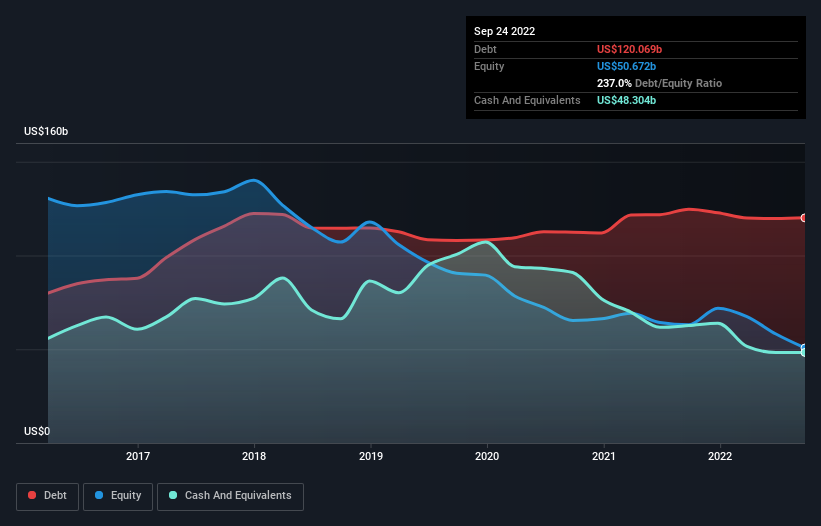Some say volatility, rather than debt, is the best way to think about risk as an investor, but Warren Buffett famously said that ‘Volatility is far from synonymous with risk.’ When we think about how risky a company is, we always like to look at its use of debt, since debt overload can lead to ruin. We note that Apple Inc. (NASDAQ:AAPL) does have debt on its balance sheet. But is this debt a concern to shareholders?
When Is Debt A Problem?
Debt and other liabilities become risky for a business when it cannot easily fulfill those obligations, either with free cash flow or by raising capital at an attractive price. If things get really bad, the lenders can take control of the business. However, a more frequent (but still costly) occurrence is where a company must issue shares at bargain-basement prices, permanently diluting shareholders, just to shore up its balance sheet. Having said that, the most common situation is where a company manages its debt reasonably well – and to its own advantage. When we examine debt levels, we first consider both cash and debt levels, together.
View our latest analysis for Apple
What Is Apple’s Debt?
The chart below, which you can click on for greater detail, shows that Apple had US$120.1b in debt in September 2022; about the same as the year before. However, it does have US$48.3b in cash offsetting this, leading to net debt of about US$71.8b.

How Healthy Is Apple’s Balance Sheet?
We can see from the most recent balance sheet that Apple had liabilities of US$154.0b falling due within a year, and liabilities of US$148.1b due beyond that. Offsetting this, it had US$48.3b in cash and US$60.9b in receivables that were due within 12 months. So it has liabilities totalling US$192.8b more than its cash and near-term receivables, combined.
Given Apple has a humongous market capitalization of US$2.10t, it’s hard to believe these liabilities pose much threat. However, we do think it is worth keeping an eye on its balance sheet strength, as it may change over time.
We use two main ratios to inform us about debt levels relative to earnings. The first is net debt divided by earnings before interest, tax, depreciation, and amortization (EBITDA), while the second is how many times its earnings before interest and tax (EBIT) covers its interest expense (or its interest cover, for short). The advantage of this approach is that we take into account both the absolute quantum of debt (with net debt to EBITDA) and the actual interest expenses associated with that debt (with its interest cover ratio).
Apple’s net debt is only 0.55 times its EBITDA. And its EBIT covers its interest expense a whopping 1k times over. So we’re pretty relaxed about its super-conservative use of debt. Fortunately, Apple grew its EBIT by 9.7% in the last year, making that debt load look even more manageable. There’s no doubt that we learn most about debt from the balance sheet. But ultimately the future profitability of the business will decide if Apple can strengthen its balance sheet over time. So if you’re focused on the future you can check out this free report showing analyst profit forecasts.
Finally, a business needs free cash flow to pay off debt; accounting profits just don’t cut it. So we clearly need to look at whether that EBIT is leading to corresponding free cash flow. Over the last three years, Apple recorded free cash flow worth a fulsome 94% of its EBIT, which is stronger than we’d usually expect. That positions it well to pay down debt if desirable to do so.
Our View
Happily, Apple’s impressive interest cover implies it has the upper hand on its debt. And the good news does not stop there, as its conversion of EBIT to free cash flow also supports that impression! Zooming out, Apple seems to use debt quite reasonably; and that gets the nod from us. While debt does bring risk, when used wisely it can also bring a higher return on equity. The balance sheet is clearly the area to focus on when you are analysing debt. However, not all investment risk resides within the balance sheet – far from it. These risks can be hard to spot. Every company has them, and we’ve spotted 2 warning signs for Apple you should know about.
If, after all that, you’re more interested in a fast growing company with a rock-solid balance sheet, then check out our list of net cash growth stocks without delay.
Valuation is complex, but we’re helping make it simple.
Find out whether Apple is potentially over or undervalued by checking out our comprehensive analysis, which includes fair value estimates, risks and warnings, dividends, insider transactions and financial health.
Have feedback on this article? Concerned about the content? Get in touch with us directly. Alternatively, email editorial-team (at) simplywallst.com.
This article by Simply Wall St is general in nature. We provide commentary based on historical data and analyst forecasts only using an unbiased methodology and our articles are not intended to be financial advice. It does not constitute a recommendation to buy or sell any stock, and does not take account of your objectives, or your financial situation. We aim to bring you long-term focused analysis driven by fundamental data. Note that our analysis may not factor in the latest price-sensitive company announcements or qualitative material. Simply Wall St has no position in any stocks mentioned.




